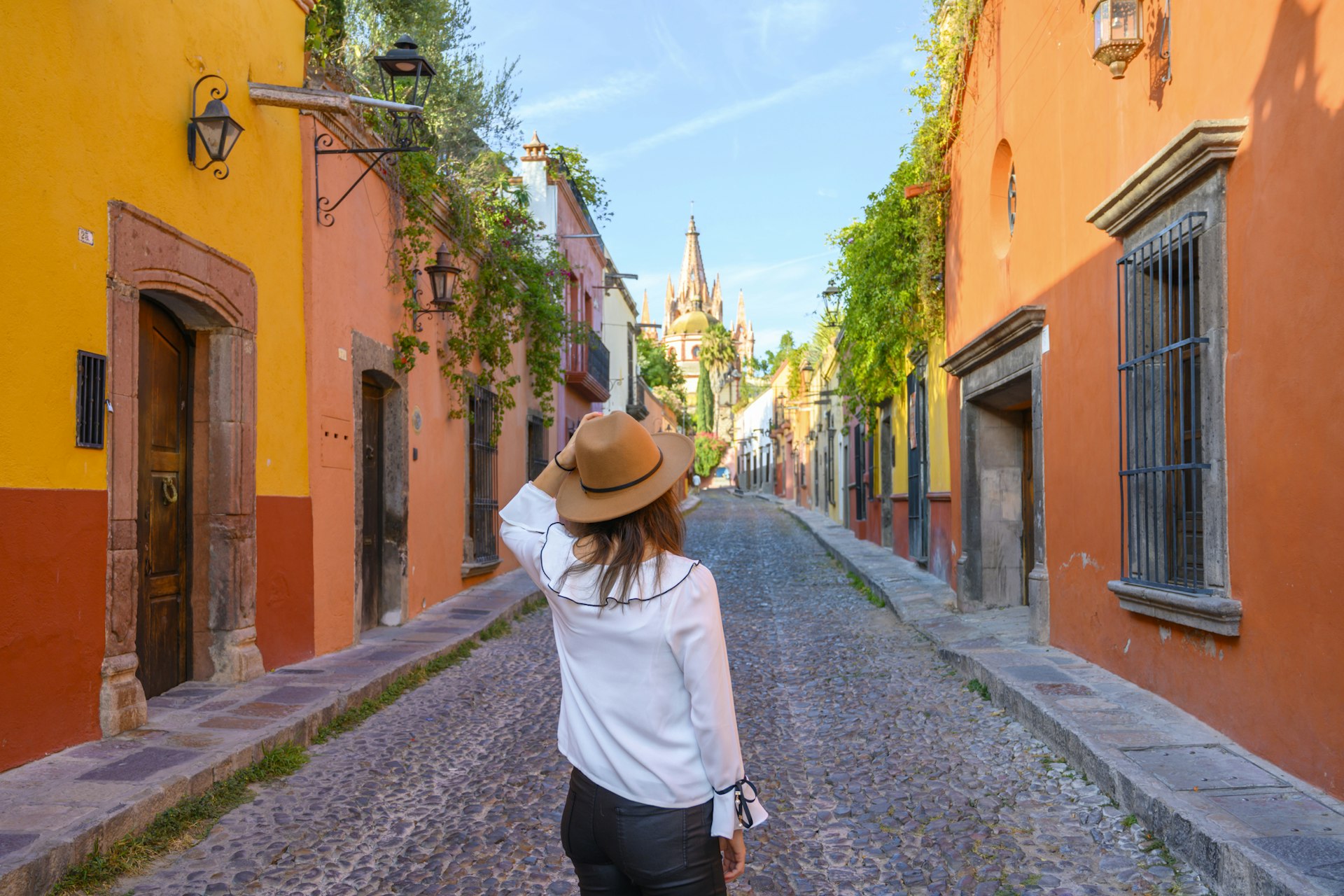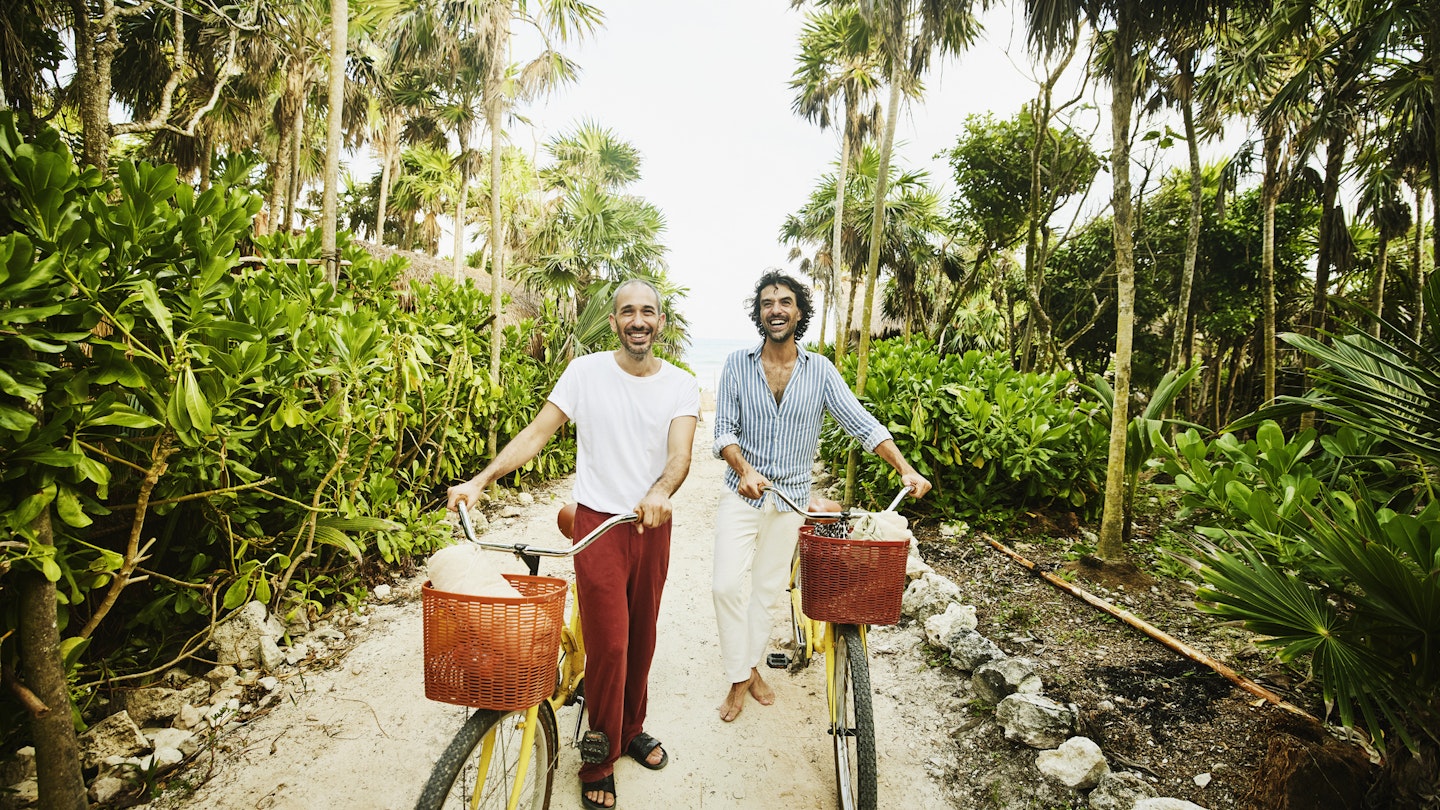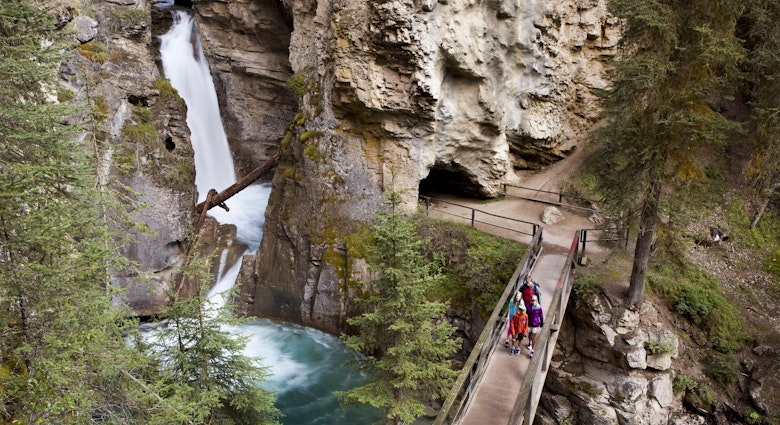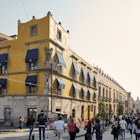Cantinas and cathedrals. Art and archaeology. Mariachis and mountains. Ruins and rainbow reefs. Mexico makes a mesmerizing escape for lovers of adventure, romance, history, culture, food, and fiery festivals.
Then there are the much-lauded beaches with clear, blue waters you’ll want to step right into and silent paradise islands without a soul in sight. From the deep canyons of Chihuahua to the peaks of Veracruz, these are the best places to visit in Mexico.
1. Mexico City
Best place for art and vibrant culture
Wondering where to go for your first trip to Mexico? Start in the bustling capital that brims with skyscrapers, markets, gardens and parks, awe-inspiring museums and more than 22 million residents.
Top Mexico City sights include “Casa Azul,” better known as Museo Frida Kahlo, where the celebrated artist lived and died. High-spirited high jinks and chihuahua-sized micheladas are on offer when catching a lucha libre (Mexican wrestling) match at the sprawling Arena México.
For artsy folks, Mexico City is where many of the country's top muralists left behind their most important works. Peruse Diego Rivera's cinematic murals in the Palacio Nacional and the social-realism work of José Clemente Orozco in the Palacio de Bellas Artes.
For a taste of culture, float along the ancient canals of Xochimilco with a mariachi band serenade, or savor piping-hot tacos from the many street-food stalls in the downtown areas before catching a show at one of the city’s 160-odd theaters. You might be lost for words, but you’ll never be short of things to do in Mexico City.
Planning tip: Couple your Mexico City stay with a trip to see the pyramids at Teotihuacán. This archaeological site is located 50km (31 miles) northeast of Mexico City, and it was one of the largest in the Americas in the pre-Columbian era. Visit during the vernal equinox to celebrate spring.
2. Isla Holbox
Best island for bioluminescence and flamingos
For its size, Isla Holbox packs a strong biodiversity punch. Only a mile wide and 26 miles long, this is one of the best places to visit in Mexico to see bubblegum-pink flamingos in the wild (head to Punta Mosquito), catch a glimpse of whale sharks (between mid-May and mid-September), and witness the mesmerizing show of bioluminescent phytoplankton glimmering in the water. Comparable to sparkling underwater fireworks, these glowing micro-organisms are best seen on moonless nights.
Holbox (pronounced hol-bosh) is a laid-back dream of an island off the northern coast of the Yucatán Peninsula.
With no vehicles to disturb the peace (cars are banned), sandy streets lead to endless beaches with warm, inviting water that’s waist-deep at most for adults. The island’s one alleged drawback? Questionable wi-fi, which encourages travelers to disconnect.

3. San Miguel de Allende
Best place for craft shops and folk art
This Mexican beauty has it all: a fantastic spring-like climate, extraordinary light, breathtaking architecture, superb handicraft shopping, and well-attended art workshops. With a high gallery-to-resident ratio, San Miguel de Allende is one of the best places for creative types to visit in Mexico.
The cobbled city has been luring retirees and bewitching artists since the first art institute opened in a former convent back in the 1930s. It then enticed Jack Kerouac, Allen Ginsberg, and Neal Cassady, who came to drink, write and read poetry in the 1960s (the latter stayed there until his death).
Today, San Miguel de Allende’s narrow, sloped streets house boutiques and cafes that dangle multicolored ribbons from wrought iron window bars, and its vibe is akin to a sepia-toned postcard from the past.
Buildings in the historic district adhere to a color code of saffron, rusty orange, ochre, terracotta, and mustard yellow. Grab a birdseye view of them from one of the city’s numerous rooftops, like Luna Rooftop Tapas Bar at Rosewood San Miguel de Allende, a firm favorite.
Planning tip: San Miguel de Allende is a three-hour drive north of Mexico City in the state of Guanajuato. Visit in spring to see the purple jacaranda trees in full bloom.
4. Bacalar
Best place for lagoon living and Maldives vibes
Everything about Bacalar is magical. Not only was it recognized by the Mexican government as a Magic Town (Pueblo Mágico) in 2006, but it’s also known for its ethereal jewel-toned lagoon, serene spas offering Mexican healing rituals and a distinct bohemian vibe.
Diners enjoy live music sessions beside bright indoor murals at tropical restaurant-meets-gallery El Manati, and wellness-minded travelers experience temazcal sweat ceremonies and copal cleansings at Casa Hormiga boutique hotel.
The prized activities in Bacalar are kayaking, paddleboarding and boating on the 26-mile Bacalar Lagoon, which is known as the Lagoon of Seven Colors (Laguna de Los Siete Colores) due to its mesmerizing gradient of blues and greens.
The town also has a 90m-deep (295ft) cenote (freshwater pool) and an old Spanish fortress. Nicknamed “the Maldives of Mexico,” unhurried Bacalar is one of the best places to visit in Mexico to get away from it all.
Planning tip: Bacalar is in the state of Quintana Roo, close to Mexico’s border with Belize. To get there using public transportation, take the ADO bus from Cancún, Playa del Carmen or Tulum.
5. Guadalajara
Best city for mariachi music, tequila and fine dining
Guadalajara, Mexico's second-largest city, is a dynamic cultural hub in the state of Jalisco. This is the tequila-producing region where Mariachi music was born, as well as charrería, Mexico’s national sport (don’t miss September’s annual International Mariachi and Charrería Festival).
Must-sees in Guadalajara include a lienzo (a charrería arena), the vivid frescoes of the Instituto Cultural de Cabaña – a testament to the genius of one-handed muralist José Clemente Orozco – and the three-story Mercado San Juan de Dios, Latin America’s largest indoor market.
Despite being deeply rooted in tradition, Guadalajara has recently gained recognition for its modern gastronomic excellence with multiple appearances on the coveted World’s 50 Best lists. Delight in upscale, globalized Mexican cuisine and cocktails at Alcalde and El Gallo Altanero.
Planning tip: Guadalajara's allure extends beyond its city limits. Use it as your gateway to Lake Chapala (one of the largest freshwater lakes in the country), the agave-clad fields of Tequila, or other charming Magic Towns like Tlaquepaque or Tapalpa.

6. Puerto Vallarta
Best place for sand, adventure and LGBTIQ+ events
With climactic and wild scenery, Puerto Vallarta is a popular vacation destination for Mexicans and foreign travelers alike. Framed by the Sierra Madre Mountains and the Bahía de Banderas (Bay of Banderas), it's a place where thrill seekers conquer rugged terrain and rappel down waterfalls, and families frolic on sun-kissed beaches – Playa Conchas Chinas, Playa Las Gemelas and Playa Mismaloya are noteworthy sandy spots.
The city is also popular among LGBTIQ+ travelers; there are gay-friendly Puerto Vallarta hotels, beach bars, restaurants, and nightlife establishments. Lovers take to the Zona Romantica (Romanic Zone) for alfresco meals, and strolling along the picturesque Malecon boardwalk, with its numerous bronze sculptures and street performers, is one of the best free things to do in Puerto Vallarta.
There's also plenty going on in the ocean, where you can see humpback whales breaching on the horizon, pods of dolphins rising from the waves, and mother turtles arriving to lay their eggs.
Planning tip: The best time to visit Puerto Vallarta to witness a baby turtle release is between July and December. Selected hotels like Marriott Puerto Vallarta Resort & Spa host newborn turtle release ceremonies.
7. Playa del Carmen
Best place for beach-meets-city vibes
Playa del Carmen is the best of both worlds: a thriving city with a bounty of enticing restaurants and pinch-me-please white sand beaches (one is even connected to a cenote). The palm-lined Quinta Avenida is the city's bustling artery with an eclectic mix of shops, lively street performances, and gourmand-pleasing international eateries.
In this versatile beach destination, families build sandcastles alongside digital nomads and solo travelers seeking spirited adventures, while night owls congregate around Calle 12 (12th St) for throbbing nights at Mandala, La Vaquita and Coco Bongo. Another Playa del Carmen accolade is the variety of rooftop bars, from the sleek UMI Rooftop and Tokyo Kitchen to the laid-back BeRoof.
From Playa (as locals call it), day trips to Riviera Maya towns like Akumal (known for turtle encounters) are all within easy reach using colectivos (minivans). There is also a direct ferry to Cozumel with Winjet or Ultramar.
8. Chichén Itzá
Best place to see pre-Columbian architecture
If you’ve always wanted to see one of the New Seven Wonders of the World, Chichén Itzá is one of the best places to go in Mexico. With origins dating back to the 5th century, this is undoubtedly the most popular of Mexico's ancient sights.
From the imposing, monolithic El Castillo pyramid (where the shadow of the plumed serpent god Kukulcán creeps down the staircase during the spring and autumn equinoxes) to the Sacred Cenote and curiously designed El Caracol observatory, Chichén Itzá is spectacular.
Planning tip: Book a Chichén Itzá tour with an English-speaking guide to learn about the mind-blowing legacy of Maya astronomers. Note that the heat, humidity and crowds in Chichén Itzá can be fierce, so try to explore the site either early in the morning or late in the afternoon, though keep in mind that the 5pm closing is a hard exit. There is also a post-sunset sound-and-light show.
9. Zihuatanejo
Best place for an Old-Mexico feel
Zihuatanejo benefited from the fortunes of neighboring resort town Ixtapa, which Mexico’s tourism body carefully developed in the 1970s. This was a direct attempt to replicate the Caribbean splendor of Cancún on the Pacific coast.
Ixtapa’s hotspot status trickled 6.5km (4 miles) south to Zihuatanejo, which feels like a sleepy fishing village elevated by a handful of relaxed seaside sanctuaries like Thompson Zihuatanejo on Playa La Ropa.
In this blissed-out traditional Guerrero town, there are storied, curiously named beaches that are great for surfing, diving, fishing and seafood-feasting in the presence of crashing waves.
Take a walk on Playa Las Gatas (Cat Beach), reportedly named after land wildcats or the whiskered nurse sharks in Zihua’s waters, or make a dash for the aforementioned Playa La Ropa (Clothes Beach), the town’s most popular beach, which incorporates a legend of a Spanish shore wreckage containing washed silk clothes.

10. La Paz
Best place for quiet beaches
La Paz, the capital of Baja California Sur, has something for every kind of beach lover. The city is a delightful springboard to adventures on the Sea of Cortez, home to 39% of the world’s marine mammals.
Around 40 minutes from La Paz, Playa El Saltito feels tranquil and isolated during the sweltering days, and its crystal waters come alive with bioluminescence at night. Though competition is tough, Playa Balandra, with its unique mushroom-like rock formation, is heralded as one of Mexico’s most beautiful beaches.
The impossible-to-miss destination in the region is the Unesco-listed Espíritu Santo island, where you can camp under a canopy of stunning stars, snorkel with playful sea lions and even peek at congresses of clumsy blue-footed boobies. A number of operators run activities here, including kayaking and snorkeling.
11. Tulum
Best place for wellness and boho vibes
Over the years, Tulum shed its former name (Zama), and its position as a secluded and sleepy beach-meets-jungle town in Riviera Maya and subsequently ripened into a world-famous pilgrimage for honeymooners, hedonists and holistic tourists. The spirituality-focused traveler will find a host of things to do in Tulum ranging from cacao ceremonies to pre-Hispanic sound healing and open-air rooftop yoga classes.
Tulum is a well-rounded destination with scrumptious restaurants and bars, and accommodations for all budgets, from waterfront shacks to top-end resorts and thatch-roofed boutique boltholes like La Valise Tulum.
The beaches are postcard-ready, the most celebrated stretch being Playa Ruinas with its strikingly well-preserved Maya ruins perched on a cliff overlooking the Caribbean Sea. There are also numerous attractions in the surrounding area, such as the massive Reserva de la Biosfera Sian Ka’an, the secluded fishing village Punta Allen and the ruins of Cobá.
Planning tip: Tulum Pueblo (the town center) is where the really cheap eats and sleeps are found, but it’s a 20-minute bike ride or 12-minute taxi to the beach. Plan ahead to find well-priced beach accommodations if that’s where you’d prefer to stay.
12. Los Cabos
Best place for glitz, glamor and parties
Sister cities Cabo San Lucas and San José del Cabo need no introduction. The former is notorious among party-hearty North American crowds, while the latter is more sedate with art galleries, celebrity-frequented luxury resorts, upscale boutiques and over-the-top decadent tequila tasting rooms.
Together, these perennially sunny spots on the southernmost tip of the Baja California Sur peninsula have become two of the top places to see in Mexico.
Under the blazing Cabo sun, golfers chase their dreams on emerald greens designed by legendary champion Jack Nicklaus, and surfers tackle world-class surf breaks.
Not many beaches are safe for swimming, but other outdoor pursuits like deep-sea fishing, spotting sea lions and whale watching (from mid-December to mid-April) keep water babies coming back.
13. Pico de Orizaba
Best place for a superlative trek
Pico de Orizaba is a symmetrical, snow-capped volcano on the border of Puebla and Veracruz states. Also called Citlaltépetl, it’s the highest peak in Mexico and the third-highest mountain in North America, with a summit elevation of around 5636m (18,491ft) above sea level.
Dormant but not extinct, the last recorded eruption was in 1846, and it is one of the most popular places to visit in Mexico for serious climbers – professionals prep there before taking on Mount Everest. Treks start from the small village of Tlachichuca, and the ascent requires some technical skills – Pico de Orizaba is the ultimate trekking and climbing challenge in Mexico.
If sea-level thrills are more to your liking, there's plenty on offer in the town of Orizaba, including a beautiful riverside walk, a couple of impressive museums and galleries and a unique "Iron Palace." The perfect introduction to Veracruz state's most appealing town is to hop into the cable car up to the park atop 1240m (4068ft) Cerro del Borrego.
From this lofty, green perch, you can admire the domes and bell towers of the city's many historic churches and the surrounding mountainous terrain, including the snowcapped summit of Pico de Orizaba.

14. Copper Canyon Railway
Best train ride
The Ferrocarril Chihuahua Pacífico (Copper Canyon Railway) remains one of Latin America’s best rail trips. Also known as the Chepe Express (from the “Ch” of Chihuahua and “P” of Pacífico), trains climb from sea level at Los Mochis to the town of Creel via the sensational rocky landscapes of the rust-hued Copper Canyon (the “Grand Canyon of Mexico”).
Vistas from your window during the train journey include alpine forests, subtropical valleys, Tarahumara villages and glimpses of some of the world’s deepest canyons.
Overnight en route at cinematic lodges overlooking the canyon's edge, or stay for days of exploring, hiking, horseback riding and even zip-lining in one of the best places to see in Mexico.
15. Oaxaca City
Best place for mezcal and cultural celebrations
Once the capital of the Zapotec Civilization, the state of Oaxaca is now better known as Mexico’s primary mezcal-producing region. Fine mezcals distilled around the state make their way to low-lit, atmospheric establishments in Oaxaca City like La Popular, El Destilado and La Mezcalerita, and savvy locals guide thirsty patrons on popular tours to experience the city one smoky sip at a time (check out Mezcouting and Oaxacking).
The frequent colorful fiestas in Oaxaca City also win smiles from cultural travelers. The city’s population swells at the start of November during Día de los Muertos (Day of the Dead) festivities, when Mexican families honor and celebrate their lost loves with round-the-clock vigils, joyful offerings, and parades.
One of the most unique things to see in Oaxaca City is the merrymaking during Noche de Rábanos (Night of the Radishes) on December 23. During this competition dating back to 1897, the young and old carve radishes into scenes that are displayed in Zócalo to much fanfare.
Planning tip: Venture two hours outside of Oaxaca City to reach Hierve el Agua, a jaw-dropping petrified waterfall-like formation. You can take a bus, rent a car or hire a driver to take you to these mineral-rich infinity pools.












